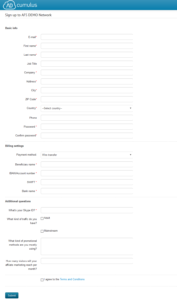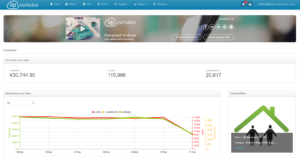Online marketing blog
Read about the latest industry trends and AdCumulus specials.
How to protect brand reputation in affiliate marketing
By on 17. May 2017.

We’ve all had our share of bad online marketing experiences. From unfortunate ad placement to ad fraud – there is a whole range of factors that can affect brand’s reputation badly.
Knowing how hard it is to change the (first) impression, marketers should do anything in their power to leave a good one.
When affiliate marketing goes wrong
Promoting a brand costs money, so it’s only natural to expect that such investment will somehow pay off.
Affiliate marketing mostly lives up to those expectations, but, as always, things can sometimes go wrong. It’s a tough world out there, and not all affiliates are fair, so giving them permission to represent your brand can sometimes backfire.
For example, brands may get promoted alongside inappropriate content (adult, racism, violence, etc.).
Then, some affiliates run websites that use intrusive marketing methods such as popups, spam email, etc. These techniques ruin user experience and can easily damage brand reputation, and you’ll probably have to work very hard to earn it back.
Also, let’s not forget about ad fraud.
So, what can you do to protect your brand’s reputation?
Put more effort into affiliates
This may be easy to forget, but affiliates are the face of your brand and you surely want that face to be respectable and trustworthy. If you invest extra efforts into the recruitment and education of affiliates, you will have to deal with less problems later.
> Choose your affiliates wisely
If a stranger walked into your office and asked for a job, would you hire them straight from the door? Probably not. There’s no reason why you should be doing so with affiliates either, especially when something as valuable as brand reputation is at steak.
Customizing affiliate sign-up forms can help you filter low-quality applicants.
Add more mandatory fields and request information such as affiliate’s physical address, contact information, website URL and traffic estimates, payment preferences, etc.
Furthermore, you can inquire about other information that is important to you, such as the industry they are gravitating towards, their traffic estimates, and more. Affiliates that are serious about working with you will not mind answering a few extra questions.
Also, don’t forget to enclose your terms and conditions.
Use them to tell affiliates more about their future responsibilities, rules and obligations. Such information can help them decide whether they are the right fit for your program. Bear in mind that not all affiliates will be native speakers, so use simple language to help them understand your terms better.
Affiliate signup form created via Affiliate Software
Before approving any applications, make sure that your future affiliates have a good reputation by doing some research.
Visit their website and try to find any valuable information about them by googling or checking forums. Many affiliates are very active online. The traces they leave behind can tell you a lot about them and help you make a decision.
This may seem like a lot of work at first, but quality rarely comes easy. It’s better to invest more time into recruiting good affiliates now, than have regrets later.
> Give affiliates enough information
Give affiliates all the information they need to properly represent your brand.
This includes clearly written terms and conditions, simple guidelines, acceptable marketing tactics and everything else that could help them be more efficient. It’s also a good idea to tell them more about your ideal target audience, their demographics, shopping habits, and more.
Let affiliates know if there is anything that is simply off the table.
Usually it’s popups, email campaigns, and similar marketing tactics that users often find intrusive. Also, prepare more creatives and text for your marketing messages in advance and make sure they are always up to date. This leaves less room for improvisation because affiliates can simply choose the one that suits them best.
And, last but not least, communicate with your affiliates.
It can be a simple welcome to the program, details about the upcoming sales, product highlights, even a survey to get their feedback.
Effective communication will make your affiliates feel like part of the team and motivate them to work harder. More importantly, it will help them understand your brand and promote it better.
It is up to you to choose how you should communicate with your affiliates. You can use email, phone, blog, Skype, your affiliate platform… even social media. Whatever you choose, respect their time. Don’t overwhelm them because too much one-sided communication might feel like spam.
For example, Affiliate Software lets you share any type of information on affiliate GUI via iFrames – from new offers to educational materials.
This way, affiliates are up to date since the moment they log in. The platform also has a built-in email sender tool that allows you to contact affiliates straight from the platform, making communication easier than ever.
Affiliate GUI customized with iFrames in Affiliate Software
Don’t neglect the importance of quality communication. Just remember that well-informed affiliates tend to be more efficient promoters.
> Reduce the number of affiliates
The more, the merrier – until it becomes too much.
Having a lot of affiliates makes it easy to lose control over who is promoting you and how.
If you’ve just accepted a new affiliate, keep an eye on them at least for a while. Check whether they respect the agreed conditions conditions, promote the brand message properly, and use approved sales methods.
In most cases, 10% of affiliates drive up to 90% of total volume.
This doesn’t mean that you should be working with a few affiliates only. After all, the purpose of affiliate marketing is to get your message across to as many people as possible.
However, if an affiliate keeps failing to drive results, they might not be a good fit for your brand and moving on could be the best option.
Always focus on quality, not quantity.
Monitor who is promoting you and how
Although most affiliates seem trustworthy at first, it is not necessarily so. The only way to make sure that everything’s being done by the book is to check it yourself.
One way is to visit affiliates’ websites manually and take a good look. However, due to various targeting options, you may not get accurate results. That is why a better option is to use a good advertising intelligence tool, such as AdInvestigate.
AdInvestigate crawls the web automatically and retrieves data about banners and landing pages of any publisher. It saves you a lot of time and provides the most accurate results, because it takes targeting into account. You can also test every service using real devices to eliminate your suspicions about fraud.
Whether you choose to check out affiliates’ sites manually or by using an ad intelligence tool, there are several things you need to look for.
> Pay attention to context
Where your ads appear does matter.
Appearing next to controversial or offending content can affect brand reputation pretty badly. Unfortunately, some marketers learn it the hard way.
Recent situation with YouTube video ads caused quite a commotion among advertisers. After YouTube’s own ad appeared as a pre-roll on an offending video, many big brands, including Walmart, Pepsi Co. and Starbucks, pulled their ad spend from YouTube. Apparently, offensive videos are not a very desirable background for ads.
Good ol’ banners face similar challenges. Some of the world’s biggest brands are unknowingly appearing on websites that promote racism, hate or violence, The Times reveals.
However, content next to which ads appear doesn’t always have to be scandalous to affect your brand – bad placement can also do the trick.
If an ad is not in accordance with its environment, it can trigger the opposite feelings from those that the brand was trying to achieve.
Take a look at some examples:
Source: Exchangewire
Source: Ryan Kuder
See how this could be a problem?
Such situations are usually attributed to the new programmatic technology. Programmatic basically eliminates human communication and automates buying and selling of ad impressions.
Although this technology was developed to make advertising better, more targeted and more efficient, it is still not 100% reliable as advertisers don’t always know where their ads may end up. As a consequence, ads are sometimes out of place. This can either go unnoticed, turn into a funny screenshot, or, in worst case scenario, cause serious problems for advertisers.
Each brand should know their limits and preferences.
While appearing next to pornography could mean a PR crisis for some brands, others may even prefer it. If a brand is not comfortable appearing next to the specific types of content, regular checks of their affiliates’ should become a must.
> Check how you’re being promoted
Bad context is not the only factor that can influence brand reputation.
Affiliates are obviously in the business to earn some money and some of them are not being very sophisticated while trying to do so.
They may build ugly websites or emails with bad formatting, misspelling, poor design, misleading content, and everything else that any decent brand would otherwise avoid like plague. Hard-selling also guarantees bad user experience as it usually implies loads of (often low-quality) ads, intrusive pop-ups or content loaded with links.
Being promoted in such environment makes it harder for a brand to attract new customers. Even worse, it takes time (and budget) to fix that bad impression.
A simple visit to affiliate’s page can reveal these flaws and help you take the necessary measures.
Look out for ad fraud
A common problem for today’s advertising industry is online ad fraud. Although ad fraud mainly drains marketing budgets, it can sometimes also compromise brand reputation.
Ad injection is a method of ad fraud that can affect brand image. It refers to placing ads on websites through browser extensions without the owner’s permission.
Ads that get injected usually appear on top of the existing ads (covering them) or on pages that normally do not have any ads at all. This is bad for advertisers because injected ads may not be concordant with the environment, they can promote direct competitors, etc.
Another reputation-harming ad fraud method is domain spoofing. In this case, publishers try to purposely decept advertisers by falsely presenting their websites as premium ones to sell their ad inventory more easily or at higher prices.
This is a problem for brands because, instead of being shown on trustworthy websites as promised (and paid for), their ads can appear on low-profile or shady places which may feature undesirable content.
Here’s what you can do to prevent this:
- Work with transparent publishers only
- Regularly monitor campaign performance and assess your traffic
- Blacklist suspicious publishers and continuously update that list
- Monitor your affiliates
These measures can help you spot ad fraud and nip it in the bud. The sooner you detect suspicious patterns or activities, the less likely it is that your brand reputation will suffer serious harm.
Better safe than sorry
Ads are usually the first step in a buyer’s journey.
This means that they usually shape your potential customers’ first impression. However, even if you have an amazing product and an even better creative, sometimes things that can go wrong.
Rogue affiliates and flaws of the new technologies can turn all your hard-earned brand reputation upside-down when you’re not looking.
If you want to prevent that, you have to be ready to invest a part of your budget. Put more effort into affiliates by customizing membership signups, monitoring their activity and filtering those that stray from your rules and expectations.
Also, a part of your time should be dedicated to monitoring those affiliates afterwards to check where and how you’re being promoted. Of course, you can make this step faster and easier by investing into a good ad intelligence tool.
Brand image is sensitive.
Make sure that the relationship between your brand and its (potential) customers is built on trust and good user experience. If you want to gamble with this, be ready for some serious make up period with your audience afterwards.










Comments